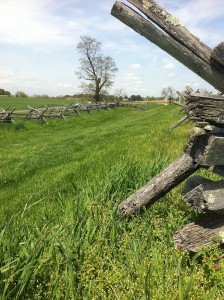I am standing in a place where thousands died in a single day. They were brothers, and they killed each other. The dead were so many, one witness observed, their bodies seemed to be stacked like cordwood. The name of this place is Bloody Lane.
I have come on pilgrimage.
On my way home from the airport in Washington, I have pulled off the highway and driven the ten miles to Antietam. Here, in 1862, Americans tore one another to pieces, with 23,000 casualties in less than twelve hours. There is a terrible site called simply the Cornfield, where the carnage was nearly indescribable. But the Bloody Lane is the whole day in miniature. You can stand here and feel where the bodies fell, and you can also feel what one poet would later call “the sadness of war, the sadness war distilled.” It is a kind of darkness that goes beyond the physical cost of so many brothers and sons taken away in their youth. It is a resignation that becomes more concentrated with each one lost, distilled into a nearly perfect despair. Here, it seems, any possibility of life is overwhelmed by death. I just stand and take it in. I am trying to remember where I have felt this before. And then it occurs to me.
It was in Achoa.
Achoa is an IDP (Internally Displaced Persons) camp in the far northeast of Teso, near the border with Karamoja. Like Antietam, it was born from civil war. When I first visited there, years ago, it was nearly the saddest place I had ever seen. The women were exhausted and sad; the children clinging to them all seemed on the verge of tears. The men moved about like ghosts. Nearly all of them were dazed with alcohol. The camp itself was a haphazard collection of huts. Two pit latrines served thousands of people. Regular raids from the Karamojong added to the afflictions of poverty, malaria and HIV/AIDS. Yet, I was amazed at how the Pilgrim staff just got out of their vans and started ministering, helping a mother here, a child there. They did what they could for the love of Christ. Their hands and faces, their medicine and prayers, brought hope. And the people knew that, of all the visitors who came and went, these would be back, bringing the possibility of the Resurrection into this Bloody Lane.
Our CEO often says, “The real enemy in Africa is not poverty. It is not malaria, or AIDS, or hunger. The real enemy is hopelessness.” As a result of civil war, people suffer all kinds of enormities, but the worst is when they succumb to the belief that nothing can change, that their future will just be an extension of their past. The Christian faith itself — and the ministry of Pilgrim — is based on the recognition that God is fundamentally committed to the project of bringing life out of death.
This means that our pilgrimage, as Christians, always is toward the darkest places because we know that there we will see the light of God. Dr. Dorothy Echodu has talked about the early years of Pilgrim in exactly these terms. In the beginning, when we were rumbling across open bush in borrowed vans looking for IDP camps that were not on any map, it might have seemed an odd choice for a pilgrimage. Surely pilgrims are headed to holy ground, sites like Chartres or Santiago de Compostela; but we were looking for the city not made with hands, the home of the Lamb of God, and we knew we would find it among the gathered tens of thousands of sick and dying people in places like Achoa. There we would find the Cross, and there as well the Empty Tomb. Out of that faith has come a school, an agricultural strategy, a ground-breaking anti-malaria protocol, and (soon) a university. Thousands have been healed and made into a force for the healing of others.
And that vision is what I bring back to Pittsburgh. This diocese has been through a dark time of division. Our churches have been harmed, our relationships torn, our souls tested. Do we believe that God is greater than all of this, that our pilgrimage toward the places of our former hopelessness will show us the reality of Christ’s Resurrection? Can we trust the power of the Holy Spirit to fuel the energy and affections of our people as they bring about life-changing mission in our own communities? Are we ready to see what God will do?

